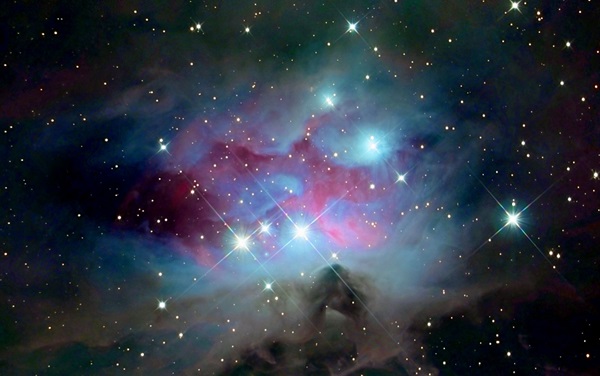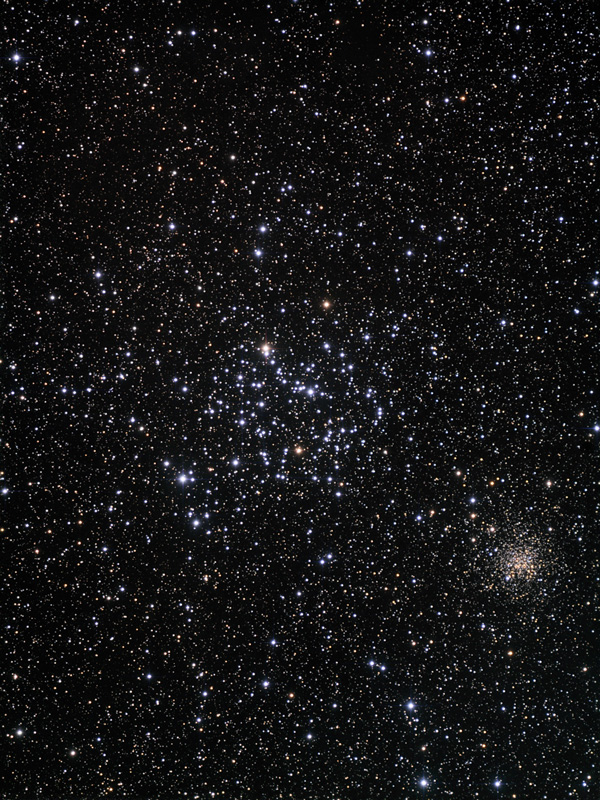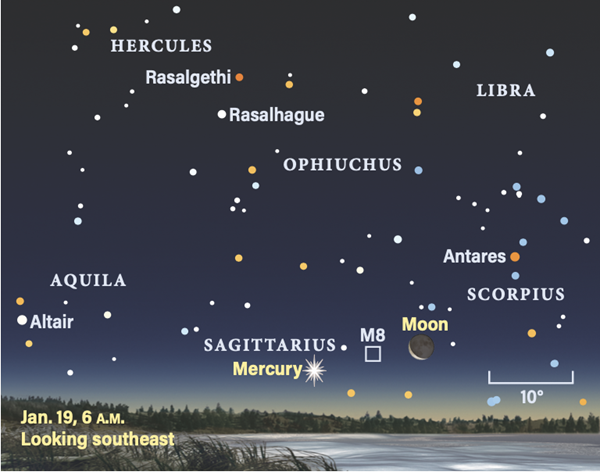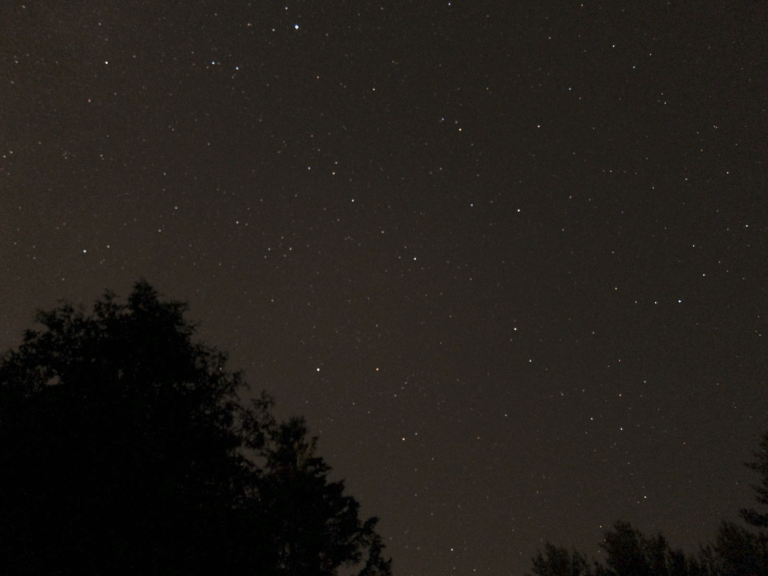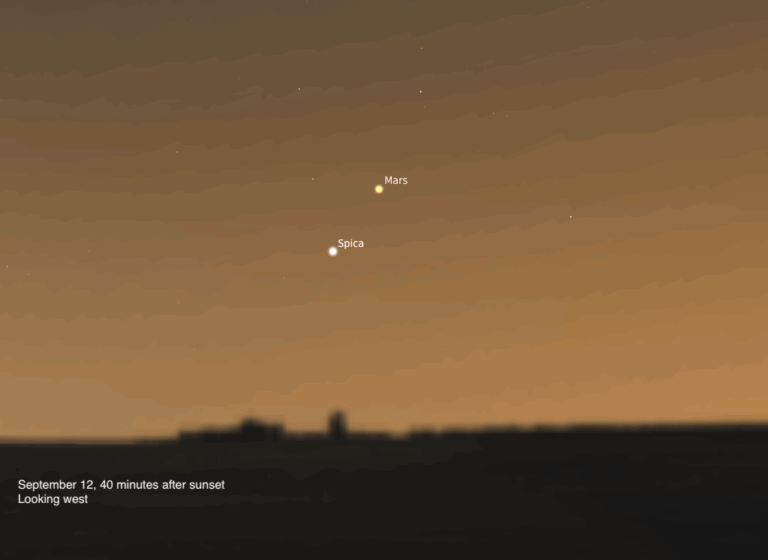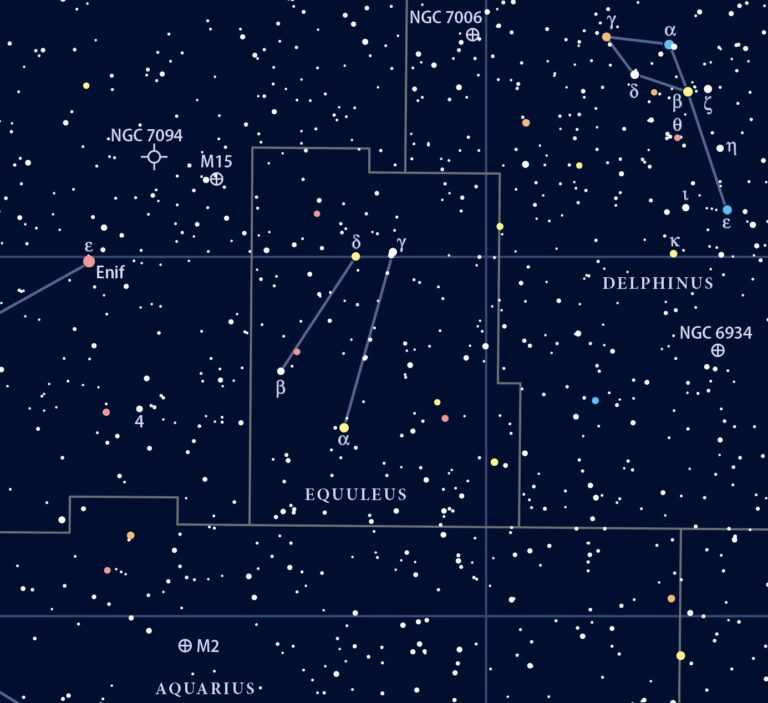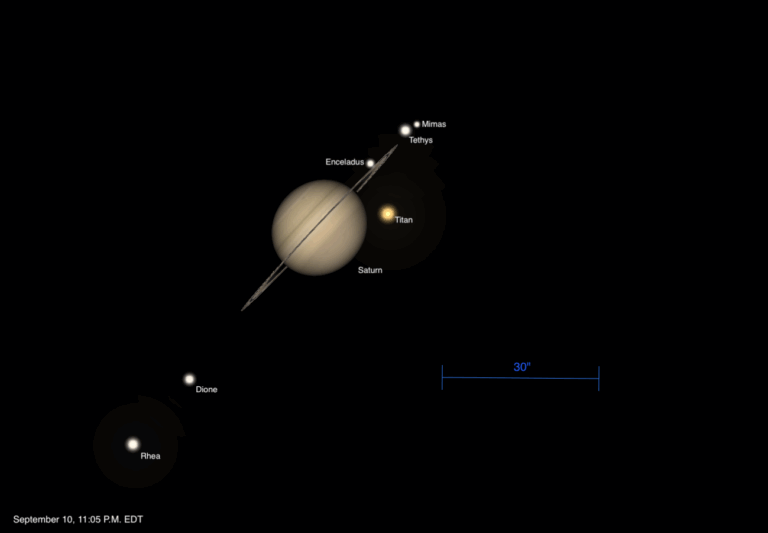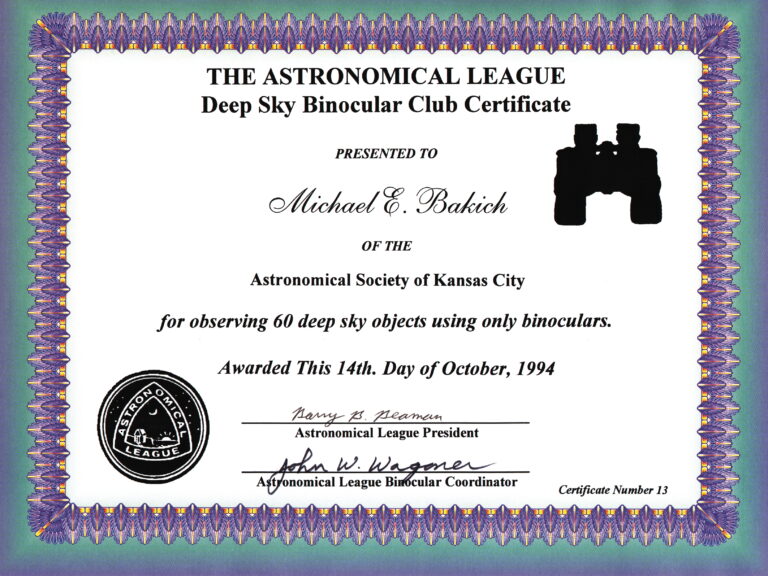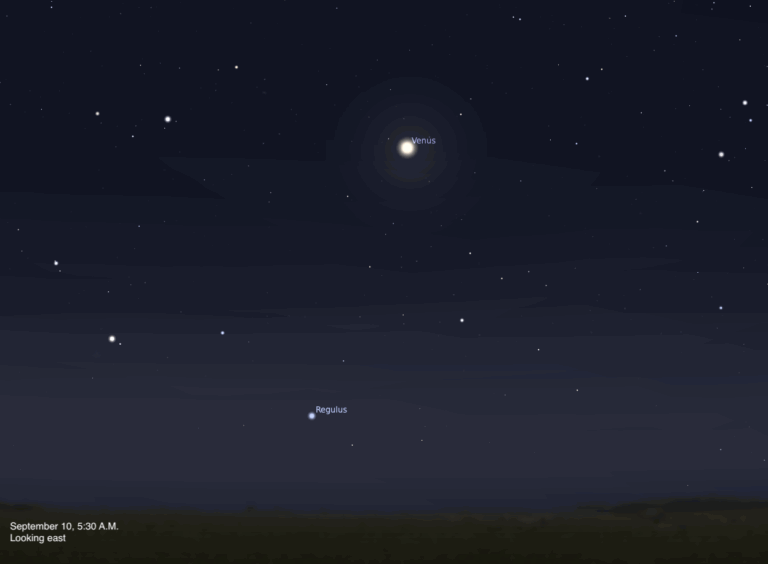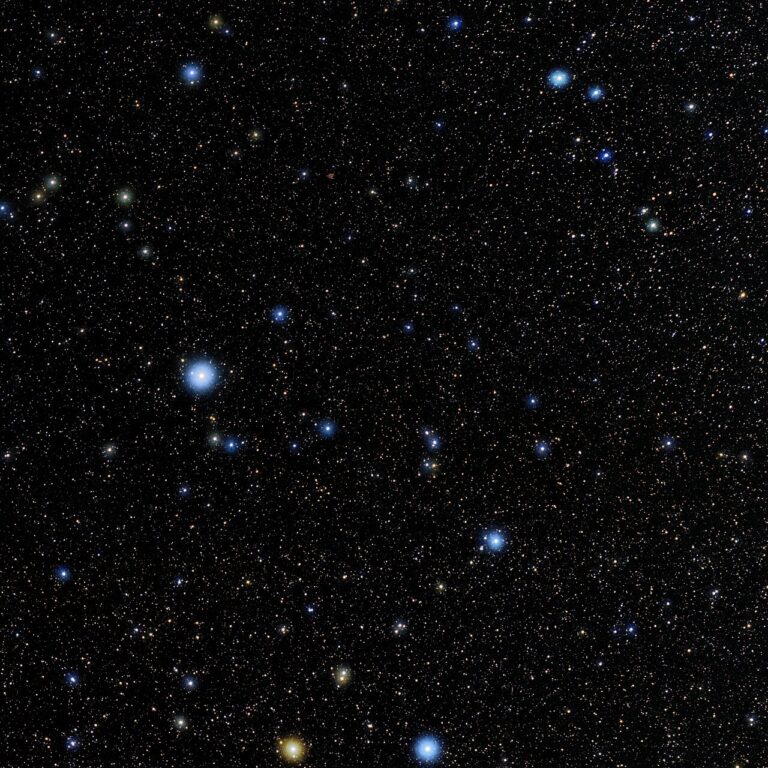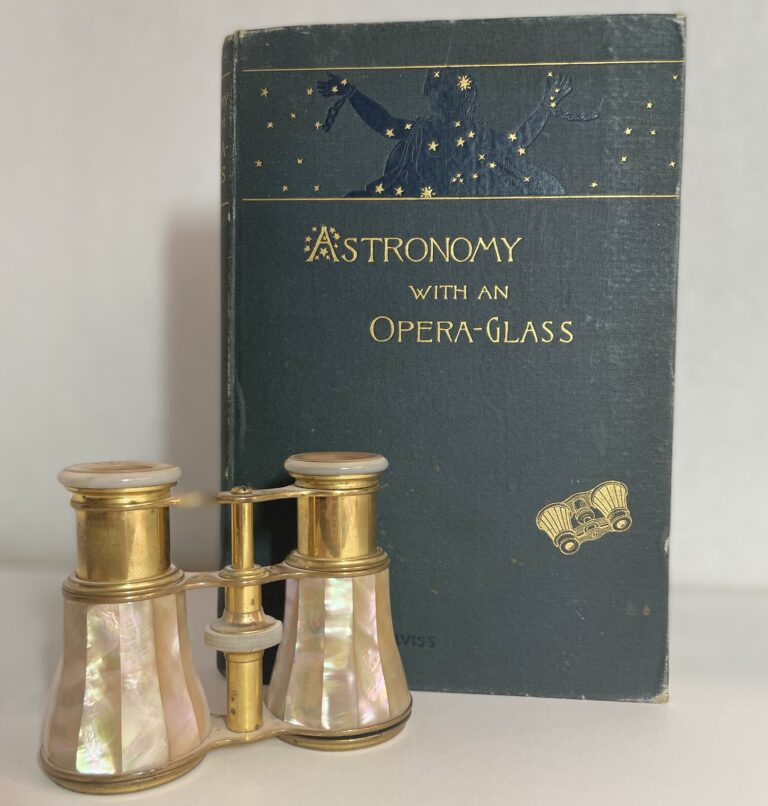Key Takeaways:
Friday, January 13
The Moon is nearly at Last Quarter phase, leaving the evening hours open for deep-sky observing. Let’s start about two hours after sunset, when Orion the Hunter is already about 30° high in the southeast and continuing to rise.
The great Orion Nebula (M42) is one of the most popular targets for night-sky observers. And it is absolutely on display tonight, glowing a ghostly green through your telescope eyepiece. But it’s not alone — this stunning nebula has a nearby neighbor that we’re going to highlight today: the Running Man Nebula, which comprises NGC 1973, NGC 1975, and NGC 1977.
A combination of emission and reflection nebulae, the Running Man lies just 0.6° north of the Orion Nebula. You’ll want a telescope on the larger side to draw out detail from this irregularly shaped cloud of gas and dust. Measuring roughly 10′ by 5′, it contains two bright, 5th-magnitude stars: 42 Orionis and 45 Orionis.
The “Running Man” himself is a bit hard to see through a telescope (as opposed to on images), so take your time. If your sky is dark and your eyes are sharp, you may just pick out this fleeing figure.
Sunrise: 7:21 A.M.
Sunset: 4:57 P.M.
Moonrise: 11:32 P.M.
Moonset: 10:57 A.M.
Moon Phase: Waning gibbous (64%)
*Times for sunrise, sunset, moonrise, and moonset are given in local time from 40° N 90° W. The Moon’s illumination is given at 12 P.M. local time from the same location.
Saturday, January 14
Last Quarter Moon occurs at 9:10 P.M. EST, though after setting shortly before noon, our satellite won’t rise again until just after midnight on the 15th.
That again leaves us dark skies after sunset; tonight, our targets lie one constellation over in Gemini, northeast of Orion. We’re looking for M35, a 5th-magnitude open cluster roughly as large as the Full Moon. It sits just over 2° north-northwest of 3rd-magnitude Propus (Eta [η] Geminorum).
Visible to the naked eye as a smudge of light from a dark site, binoculars or a small scope will reveal many of the cluster’s myriad stars, which ultimately number in the hundreds. This grouping of young suns lies some 2,800 light-years away and is moving toward the solar system at some 10,800 mph (17,400 km/h).
With your low-power scope or eyepiece, situate M35 in the middle of your field of view. Now, look just 0.4° southwest of M35 — do you see a faint fuzzball? That’s NGC 2158, a magnitude 8.6 open cluster that, at roughly 1 billion years in age, is much older than 100-million-year-old M35.
Sunrise: 7:21 A.M.
Sunset: 4:58 P.M.
Moonrise: —
Moonset: 11:19 A.M.
Moon Phase: Waning gibbous (54%)
Sunday, January 15
Instead of looking east shortly after sunset tonight, let’s look northwest, instead. There, the mighty Cygnus the Swan is slowly sinking toward the horizon. The most prominent star in this constellation is 1st-magnitude Deneb, which marks the Swan’s tail.
West of this star and about 1.4° east of magnitude 4.5 Theta (θ) Cygni lies NGC 6826, better known as the Blinking Planetary Nebula. Glowing softly at 8.8, this object is a dying star that has shed its outer layers and is now lighting them up from within, creating the spherical cloud of gas we call a planetary nebula.
But where does the blinking moniker come from? The nebula itself glows steadily, but it’s subject to a unique optical illusion caused by the structure of the human eye. Center the object in a medium or large scope and look directly at it. What you’ll see is the central star responsible for the nebula, which shines at 11th magnitude — but you won’t see much, if any, of the nebula around it! Then, look slightly away from the star, toward the edge of your field of view, moving only your gaze, not the telescope. The faint, fuzzy nebula should pop right into view out of the corner of your eye, while the central star now seems to disappear.
Switching between direct and averted vision will cause the nebula to “blink” in and out of view like this because the cells directly at the center of your eye are better at picking up bright objects, while those that are off-center are more sensitive to fainter ones.
Sunrise: 7:20 A.M.
Sunset: 4:59 P.M.
Moonrise: 12:36 A.M.
Moonset: 11:43 A.M.
Moon Phase: Waning crescent (43%)
Monday, January 16
We’re gearing up for a gorgeous meeting of the worlds next week, when Venus and Saturn will sit a mere 21″ apart. Get acquainted with finding them in the sky by looking southwest about an hour after sunset, when the pair are roughly 10° high in Capricornus.
Bright Venus blazes at magnitude –3.9, easily visible in the falling twilight as a prominent evening star. Today, Saturn still sits over 6.5° to its east and is a much fainter magnitude 0.8. The ringed planet is close to the 3rd-magnitude star Deneb Algedi, which lies 1.5° to Saturn’s south.
Through a telescope, Venus shows off a nearly full disk some 94 percent illuminated and spans 11″. Saturn appears slightly larger, stretching about 15″ across, with its rings on full display. Look, too, for its brightest moon Titan, which today is about 2.5′ due east of the planet’s center.
Over the next week or so, the two planets will draw closer as Venus skips through the sky; the worlds will come closest on the 22nd. Make sure to check out next week’s column for more details.
Sunrise: 7:20 A.M.
Sunset: 5:00 P.M.
Moonrise: 1:44 A.M.
Moonset: 12:10 P.M.
Moon Phase: Waning crescent (33%)
Tuesday, January 17
Comet C/2022 E3 (ZTF) has been nabbing headlines lately, and with good reason. Currently predicted to be the best comet of the year, it’s quickly passing through Boötes on its way toward Draco.
The best time to observe the comet is early in the morning, several hours before dawn. This morning, look for it some 8.5° east-northeast of Nekkar (Beta [β] Boötis) and just less than 7° west of Tau (τ) Herculis. In just a few days, it will pass by the galaxy pair NGC 5907 and M102. The two lie about 12.5° northwest of the comet’s current position today.
Glowing green thanks to dicarbon in its temporary atmosphere, ZTF is easily visible through binoculars or any small scope. It just recently rounded the Sun and is headed for its closest approach to Earth on February 1, brightening as it nears our planet. Many astronomers and observers alike hope it will reach 6th or even 5th magnitude, rendering it visible to the naked eye under good conditions. Because we write this column in advance, it could have already reached that brightness — you can check out the latest details on ZTF via the Comet Observation Database website at www.cobs.si.
Sunrise: 7:19 A.M.
Sunset: 5:01 P.M.
Moonrise: 2:56 A.M.
Moonset: 12:44 P.M.
Moon Phase: Waning crescent (23%)
Wednesday, January 18
Mercury sits stationary against the background stars of Sagittarius at 7 A.M. EST. You can easily catch the tiny planet about an hour before sunrise, when it is nearly 4° high in the southeast and rising. It is currently magnitude 0.5, brightening each day — it will reach magnitude –0.1 by the end of the month. Through a telescope, Mercury appears some 9″ across and is a 31-percent-lit waxing crescent. After reaching this stationary point, the planet will now begin moving east, or prograde, against the background stars.
Look to the right (south) of Sagittarius and you’ll easily spot Scorpius, whose top half has cleared the horizon an hour before the Sun is due to rise. The Scorpion’s bright, ruby-hued heart, Antares, shines at magnitude 1.1, with the 26-day-old Moon nestled nearby, just 2° east of the prominent red giant star. The Moon will rendezvous with Mercury tomorrow, so we’ll be sure to return and check out that lovely pairing.
Pluto, also in Sagittarius, is in conjunction with the Sun at 10 A.M. EST.
Sunrise: 7:19 A.M.
Sunset: 5:03 P.M.
Moonrise: 4:11 A.M.
Moonset: 1:28 P.M.
Moon Phase: Waning crescent (14%)
Thursday, January 19
Let’s return to Sagittarius this morning to enjoy a beautiful tableau: Mercury and the Moon, with the gorgeous Lagoon Nebula (M8) between them.
Our satellite is now a 27-day-old waning crescent, just 8 percent lit. It lies just over the border from Sagittarius in Ophiuchus and sits 4° high around 6 A.M. local time. To the Moon’s lower left (east) is Mercury, now magnitude 0.4 (already 0.1 magnitude brighter than yesterday) and 1° high at the same time. You’ll need a clear southeastern horizon to spot it so low this early — if you can’t quite see it, give it time. As the sky brightens, the planet will rise higher, offering a better view.
But if you can see both objects this early — while the sky is still relative dark — look between them with binoculars or a telescope. About 6° east-northeast of the Moon is M8, commonly called the Lagoon Nebula. A bright star-forming region, the Lagoon glows at magnitude 4.6 and spans about 90′ by 40′. A young open cluster of stars, NGC 6530, glows within the eastern portion of the nebula.
Sunrise: 7:18 A.M.
Sunset: 5:04 P.M.
Moonrise: 5:26 A.M.
Moonset: 2:24 P.M.
Moon Phase: Waning crescent (7%)
Friday, January 20
The Moon, crossing Sagittarius now, passes 7° due south of Mercury at 3 A.M. EST.
A few hours later, Jupiter reaches perihelion, the closest point to the Sun in its orbit, at 7 A.M. EST. The gas giant will then be 460 million miles (740 million kilometers) from our star. You can catch the mighty planet in the evening sky. Look southwest to find Jupiter still more than 40° high an hour after sunset, floating in the constellation Pisces. It appears to the right (east) of the famous Circlet asterism.
A bright magnitude –2.2, Jupiter is easily visible to the naked eye. With a telescope, the planet appears a whopping 37″ across. All four of its Galilean moons are strung out in a line to the planet’s west tonight. Appearing closest to the planet is Ganymede, followed by Io, Europa, and finally Callisto, some 8′ from Jupiter’s center. The planet and its satellites will remain visible for you to enjoy for several hours, finally setting around 10 P.M. local time.
Sunrise: 7:18 A.M.
Sunset: 5:05 P.M.
Moonrise: 6:34 A.M.
Moonset: 3:33 P.M.
Moon Phase: Waning crescent (2%)

